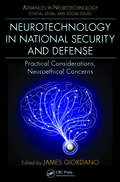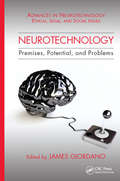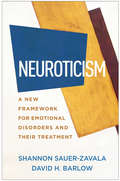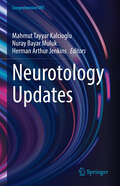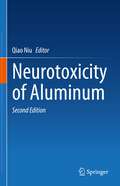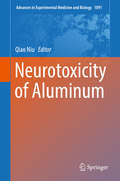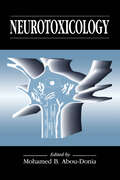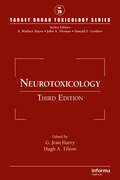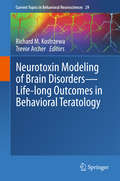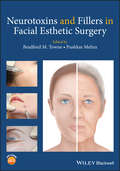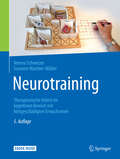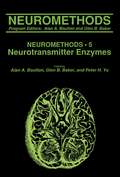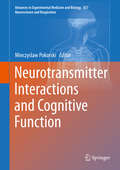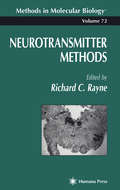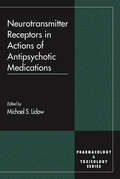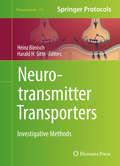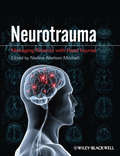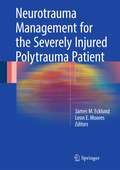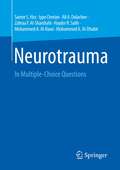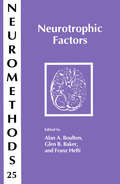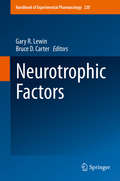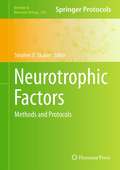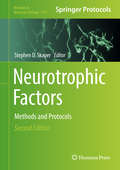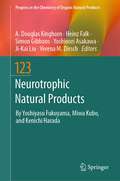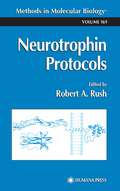- Table View
- List View
Neurotechnology in National Security and Defense: Practical Considerations, Neuroethical Concerns (Advances in Neurotechnology)
by James GiordanoNeurotechnology in National Security and Defense: Practical Considerations, Neuroethical Concerns is the second volume in the Advances in Neurotechnology series. It specifically addresses the neuroethical, legal, and social issues arising from the use of neurotechnology in national security and defense agendas and applications. Of particular concer
Neurotechnology: Premises, Potential, and Problems (Advances in Neurotechnology)
by James GiordanoNew technologies that allow us to investigate mechanisms and functions of the brain have shown considerable promise in treating brain disease and injury. These emerging technologies also provide a means to assess and manipulate human consciousness, cognitions, emotions, and behaviors, bringing with them the potential to transform society. Neurotech
Neuroticism: A New Framework for Emotional Disorders and Their Treatment
by David H. Barlow Shannon Sauer-ZavalaNeuroticism--the tendency to experience negative emotions, along with the perception that the world is filled with stressful, unmanageable challenges--is strongly associated with anxiety, depression, and other common mental health conditions. This state-of-the-art work shows how targeting this trait in psychotherapy can benefit a broad range of clients and reduce the need for disorder-specific interventions. The authors describe and illustrate evidence-based therapies that address neuroticism directly, including their own Unified Protocol for transdiagnostic treatment. They examine how neuroticism develops and is maintained, its relation to psychopathology, and implications for how psychological disorders are classified and diagnosed.
Neurotology Updates (Comprehensive ENT)
by Nuray Bayar Muluk Mahmut Tayyar Kalcioglu Herman Arthur JenkinsThis book provides comprehensive and up-to-date general information and evaluation of the diagnostic and therapeutic options available to individuals suffering from neurotologic diseases. Neurotology is a fast-developing area of science. Even fundamental terminology, such as the meaning of vestibular symptoms, has only recently been established due to the rapid development of vestibular research. This volume discusses the fundamental sciences, and the clinical application of treatments in neurotology, as well as the most recent research. It is aimed at assisting physicians in making the most effective judgments regarding the management of care for their patients. Diagnosing patients with vestibular symptoms such as vertigo, dizziness, unsteadiness, and oscillopsia requires consideration of symptoms and indicators of neurotologic illnesses. The majority of diagnoses may be made right at the patient's side. A grasp of important diagnostic concepts is vital for all practicing neurologists, who regularly assess whether such patients merit immediate diagnostic testing or hospital admission. This book emphasizes understanding how to take a focused medical history and perform a thorough physical examination on a patient experiencing vestibular symptoms or suspected of having a neurotologic condition. This up-to-date reference should be part of the collections of all otolaryngologists, head and neck surgeons, audiologists, neurologists, neurosurgeons, and residents interested in providing the best possible care for patients.
Neurotoxicity of Aluminum
by Qiao NiuThis book reviews the scientific literature and the authors’ own research linking aluminum neurotoxicity with cognitive impairment and Alzheimer’s disease (AD). It focuses on aluminum levels in the brain, region-specific and subcellular distribution, its relation to neurofibrillary tangles and amyloid beta—the pathological features of AD, and the possible mechanism of aluminum inducing these pathological features. Further, the book stresses the importance of aluminum’s complex speciation chemistry in relation to biology, and details aluminum’s mechanism in oxidative stress and cell death, especially in connection with apoptosis and necroptosis. The electrophysiological variation and synaptic plasticity induced by aluminum are covered, while the metal’s debatable role in AD and the cross-talk between aluminum and genetic susceptibility are also discussed, and more recently the relationship between aluminum-induced epigenetic modification on DNA and non-coding RNAs and neuron death and synaptic impairment.The second edition updates eight chapters according to the most recent researches. Content about aluminum-induced AD-like pathological features, neurotoxic effects of aluminum and aluminum alloy nanoparticles(TBD) and alumina nanoparticles induced neurotoxic and neurodevelopmental toxic effects is also added. In closing, this book provides readers with a systematic summary of aluminum neurotoxicity.
Neurotoxicity of Aluminum (Advances in Experimental Medicine and Biology #1091)
by Qiao NiuThis book reviews the scientific literature and the authors’ own research linking aluminum neurotoxicity with cognitive impairment and Alzheimer’s disease (AD). It focuses on aluminum levels in the brain, region-specific and subcellular distribution, and its relation to neurofibrillary tangles and amyloid beta. Further, the book stresses the importance of aluminum’s complex speciation chemistry in relation to biology, and details aluminum’s mechanism in oxidative stress and cell death, especially in connection with apoptosis and necroptosis. The electrophysiological variation and synaptic plasticity induced by aluminum are covered, while the metal’s debatable role in AD and the cross-talk between aluminum and genetic susceptibility are also discussed. In closing, the book reviews the neurotoxic effects of aluminum and its important role in the pathogenesis of AD. Given its depth of coverage, the book provides readers with a systematic summary of aluminum neurotoxicity.
Neurotoxicology
by Mohamed B. Abou-DoniaNeurotoxicology provides a thorough understanding of neurotoxicology through its integration of multilateral ideas covering several disciplines, including chemistry, biochemistry, anatomy, physiology, and pathology. It discusses neurotoxic agents, describes the methods for studying neurotoxic actions, covers factors affecting neurotoxicity, and inc
Neurotoxicology (Target Organ Toxicology Series)
by Hugh A. Tilson G. Jean HarryThis new edition presents an integrated approach to neurotoxicology, the study of organisms' responses to changes in their environment and how interruption of the flow of information by chemical exposure causes a wide range of effects - from learning deficits, sensory disturbances in the extremities, and muscle weakness to seizures and signs simila
Neurotoxin Modeling of Brain Disorders -- Life-long Outcomes in Behavioral Teratology
by Richard M. Kostrzewa Trevor ArcherThis book is authored by leading experts who made major discoveries in neuroteratology research focused on modeling human neural developmental disorders. Individual chapters address ADHD (attention-deficit hyperactivity disorder), Lesch-Nyhan disease, psychoses and schizophrenia, autism, and models of Parkinson's Disease and tardive dyskinesia. The effects of perinatal stress and agonist insults on life-long outcomes are addressed, as well as the overall effects of perinatal neurotoxins on development of specific neural phenotypic systems. The book provides a unique compendium on how perinatal insults of various types can produce effects in brain that persist throughout the life span. Researchers can derive insight into experimental approaches in this research field; clinicians can develop insights into the influences of the many noxious and seemingly innocuous substances that might influence brain development in children.
Neurotoxins and Fillers in Facial Esthetic Surgery
by Pushkar Mehra Bradford M. TowneThis book offers a detailed, practical guide to incorporating minimally invasive cosmetic surgery into dental practice. Chapters thoroughly examine all aspects of using these materials in practice, and present step-by-step techniques for injecting and placing neurotoxins and fillers, with specific recommendations for product selection and in-depth information on case management. Anatomical drawings and clinical photographs depict the procedures and concepts described. From patient evaluation, treatment planning, and product selection to techniques, managing complications, and marketing the service, Neurotoxins and Fillers in Facial Esthetic Surgery provides a complete resource for using these techniques in practice. Coverage encompasses facial anatomy, neurotoxins, cosmetic fillers, hyaluronic acid dermal fillers, Radiesse™ calcium hydroxylapatite injectable filler, pearls and pitfalls, and how to build your practice. Offers a complete but easy-to-use-reference on all aspects of how to set up a minimally invasive cosmetic facial surgery service within an oral and maxillofacial surgery practice Surveys the range of products available in detail from an objective viewpoint Presents how-to techniques for injecting and placing neurotoxins and fillers Neurotoxins and Fillers in Facial Esthetic Surgery is an essential reference for any oral and maxillofacial surgeon or general dentist wishing to add minimally invasive cosmetic surgery to their repertoire.
Neurotraining
by Verena Schweizer Susanne Wachter-MüllerEine der wertvollsten epidemiologischen Studien, das Oxfordshire Community Stroke Project, berichtete 1983, daB 1,95 von 1000 Personen pro Jahr an einem ersten Schlaganfall (Apoplexie) erkranken. In dem gleichen Bericht werden 13 wei tere zuverHissige epidemiologische Bevolkerungsstudien zitiert. Die geschatzte totale Inzidenz einschlieBlich der Ruckfalle betrug 2,2 pro 1000 im Jahr. Aufgrund von zahlreichen anderen Studien in GroBbritannien, Danemark, Finnland, der Schweiz und den USA darf angenommen werden, daB die Haufigkeit des Schlag anfalls in den Industriestaaten der westlichen Zivilisationen von Land zu Land nur geringen Schwankungen unterworfen ist. Extrapoliert auf die Schweiz wurde dies bedeuten, daB wir in unserem Land pro Jahr etwa mit 12000 Patienten, die den ersten Schlaganfall oder einen Ruckfall erleiden, zu rechnen haben. Ange sichts der hohen Mortalitatsrate wahrend der ersten 3 Monate nach dem Schlag anfall einerseits und der Tatsache, daB viele Patienten nur leicht erkranken und eine sehr gute spontane Regenerationstendenz zeigen andererseits, ist es nicht ver wunderlich, daB nur ein Teil der Erkrankten besonderer rehabilitativer MaBnah men bedarf. Trotzdem kann man mit Harris (1971) annehmen, daB den Schlagan fall iiberlebende Hemiplegiker etwa 25% aller schwer behinderten Menschen in einer beliebigen Bevolkerungsgruppe in Westeuropa ausmachen. Eine detaillierte australische Studie ergab, daB man auf eine Bevolkerung von 100000 Personen mit jahrlich etwa 110 den Schiaganfalliangere Zeit uberlebenden neuen Schwer behinderten rechnen muB, die dringend einer Krankenhausbehandlung oder einer Rehabilitation in einem spezialisierten Rehabilitationszentrum bedurfen. Bei einer Untersuchung in Azmoos/Kanton St.
Neurotransmitter Interactions and Cognitive Function
by Mieczyslaw PokorskiA host of neurotransmitters and neuroactive substances underlies respiratory regulation in health and disease. The centerpiece of investigations regarding adaptation to hypoxia and sensorial perception has been the dopaminergic system. It is now clear that a complex interaction among various neuroactive substances, rather than a single one, forms the basis of respiratory changes. The research on neurotransmitter interactions provides the knowledge of how the brain functions and a new level of understanding of mind-to-body connection, which opens up avenues for novel therapeutic interventions.
Neurotransmitter Methods
by Richard C. RayneThis outstanding and comprehensive collection of user-friendly protocols is essential for neuroscientists who wish to localize, identify, purify, and/or quantify neurotransmitters. The easily reproducible methods presented cover a broad spectrum of approaches involving cell and organ culture, histochemistry, immunochemistry, in situ hybridization, cell fractionation, liquid chromatography, mass spectrometry, in vivo microdialysis, and voltammetry. These approaches are optimized for use by neuroscientists, are often complementary, and can be employed in tandem with powerful effect.
Neurotransmitter Receptors in Actions of Antipsychotic Medications (Handbooks in Pharmacology and Toxicology)
by Michael S. LidowYears of extensive investigation into neurophysiology, neurochemistry, and behavioral pharmacology have produced an understanding of antipsychotic medication action that is much more refined than the original dopamine hypothesis. New perspectives offer an array of novel drugs - drugs that pose a lower risk of developing tardive dyskinesia, have few
Neurotransmitter Transporters
by Heinz Bönisch Harald H. SitteThis book is a representative survey of the current status of the structure, function, regulation and molecular pharmacology of Neurotransmitter Transporters. It provides an overview of insights generated in the past five years. The volume serves as a useful compendium of current concepts and an inspiring starting point. It is a source for students interested in this emerging field as well as for experienced scientists looking for an update.
Neurotrauma
by Nadine Abelson-MitchellNeurotrauma: Managing Patients with Head Injuries is a comprehensive, holistic, evidence-based approach to the primary, secondary and tertiary care of a person with neurotrauma.Using a patient-centred needs approach to enhance the quality of care of head injured patients, family and carers, this multidisciplinary book enables the reader to apply the knowledge, skills and attitudes learned to the practice of neurotrauma in all settings. It explores:Anatomy and physiology of the brainPharmacology for neurotrauma patientsAssessment of the patient with neurotraumaManagement of neurotrauma in a range of settings including at the scene, in the emergency department, and at the hospitalNeuro-rehabilitationCommunity careNursing management of the patientThis practical resource includes activities, exercises, and ethical and legal considerations throughout, making it ideal reading for all staff working in neuroscience, emergency, critical and rehabilitation settings.
Neurotrauma Management for the Severely Injured Polytrauma Patient
by James M. Ecklund Leon E. MooresThis text addresses many of the questions which occur when medical professionals of various disciplines interact and have different plans and interventions, each with its own valid scientific and/or experience-based rationale: Questions involving tourniquet placement, ideal fluids and volumes for resuscitation, VTE prophylaxis and many other management considerations. Straightforward decisions in the patient with a single diagnosis often conflict when applied to the neurologically injured polytrauma patients. Neurotrauma Management for the Severely Injured Polytrauma Patient answers as many of these questions as possible based on the current literature, vast experience with severe neurotrauma in the current conflicts in Afghanistan and Iraq, and the experience of trauma experts across the globe as well as proposes areas for future study where answers are currently less clear.
Neurotrauma: In Multiple-Choice Questions
by Samer S. Hoz Ali A. Dolachee Hayder R. Salih Iype Cherian Zahraa F. Al-Sharshahi Mohammed A. Al-Rawi Mohammed A. Al-DhahirNeurotrauma in Multiple Choice Questions is the FIRST review book to use the multiple-choice question format in neurosurgical trauma. Students of neurosurgery, the resident, the fellow, the younger neurosurgeon preparing for exams or practice, and even the later stage neurosurgeon are the target audience of this book. The information in this work is in accordance with the most up-to-date best practice evidence, with a style that mirrors the format adopted by the majority of local, regional, and international board examinations. The strategy and format of the questions provide a stepwise progression from definition to surgical decision-making, to a comprehensive and concise overview of neurological trauma.
Neurotrophic Factors
by Alan A. Boulton Glen B. Baker Franz HeftiLeading researchers present those techniques that have been crucial to propelling the neurotrophic factors field to its current state of high visibility. The techniques range from molecular biological methods used for cloning and production, to cell culture methods for assessing biological activities, to animal models of nervous system injury (necessary for the development of therapeutic agents from neurotrophic factors).
Neurotrophic Factors
by Gary R. Lewin Bruce D. CarterThis book provides critical reviews of the role of neurotrophins and their receptors in a wide variety of diseases including neurodegenerative diseases like Huntington's syndrome, cognitive function, psychiatric disorders such as clinical depression, Rett syndrome, motoneurone disease, spinal cord injury, pain, metabolic disease and cardiovascular disease. It also contains contributions from leaders in the field dealing with the basic biology, transcriptional and post-translational regulation of the neurotrophins and their receptors. The present book will review all recent areas of progress in the study of neurotrophins and their biological roles.
Neurotrophic Factors
by Stephen D SkaperNervous system development evolves from the well-orchestrated processes of neural induction, cell proliferation, differentiation, cell migration, survival, and synapse formation. Among these environmental cues, neurotrophic factors are secreted proteins that promote neurite outgrowth, neuronal cell differentiation and survival both in vivo and in vitro. Nerve growth factor (NGF) is the founding and best characterized member of the neurotrophin family of neurotrophic polypeptides. Neurotrophic Factors: Methods and Protocols presents a selection of protocols and procedures which make use of cellular, tissue, and whole animal models which can be applied to the investigation of neurotrophic factors and other agents impacting on these systems. Chapters cover a wide-range of topics such as dealing with the culture of neurons and glia from the central and peripheral nervous systems, neuron-glia co-culture models, and cell-based assays for the evaluation of neuroprotective molecules, as well as assays which can be applied to the study of agents with neuroregenerative potential. Protocols describing viral- and nanoparticle-based delivery methods to neural cells are also presented, following by chapters dealing with organotypic slice culture protocols. Lastly, several chapters are dedicated to in vivo lesion models of relevance to nervous system pathology, which can be applied to the investigation of neurotrophic factors and peptides. Written in the successful Methods in Molecular BiologyTM series format, chapters include introductions to their respective topics, lists of the necessary materials and reagents, step-by-step, readily reproducible protocols, and notes on troubleshooting and avoiding known pitfalls. Authoritative and easily accessible, Neurotrophic Factors: Methods and Protocols seeks to serve both professionals and novices alike with its well-honed methodologies in an effort to further our knowledge of what has been described as the last frontier of science.
Neurotrophic Factors
by Stephen D. SkaperNervous system development evolves from the well-orchestrated processes of neural induction, cell proliferation, differentiation, cell migration, survival, and synapse formation. Among these environmental cues, neurotrophic factors are secreted proteins that promote neurite outgrowth, neuronal cell differentiation and survival both in vivo and in vitro. Nerve growth factor (NGF) is the founding and best characterized member of the neurotrophin family of neurotrophic polypeptides. Neurotrophic Factors: Methods and Protocols presents a selection of protocols and procedures which make use of cellular, tissue, and whole animal models which can be applied to the investigation of neurotrophic factors and other agents impacting on these systems. Chapters cover a wide-range of topics such as dealing with the culture of neurons and glia from the central and peripheral nervous systems, neuron-glia co-culture models, and cell-based assays for the evaluation of neuroprotective molecules, as well as assays which can be applied to the study of agents with neuroregenerative potential. Protocols describing viral- and nanoparticle-based delivery methods to neural cells are also presented, following by chapters dealing with organotypic slice culture protocols. Lastly, several chapters are dedicated to in vivo lesion models of relevance to nervous system pathology, which can be applied to the investigation of neurotrophic factors and peptides. Written in the successful Methods in Molecular Biology(tm) series format, chapters include introductions to their respective topics, lists of the necessary materials and reagents, step-by-step, readily reproducible protocols, and notes on troubleshooting and avoiding known pitfalls. Authoritative and easily accessible, Neurotrophic Factors: Methods and Protocols seeks to serve both professionals and novices alike with its well-honed methodologies in an effort to further our knowledge of what has been described as the last frontier of science.
Neurotrophic Natural Products (Progress in the Chemistry of Organic Natural Products #123)
by A. Douglas Kinghorn Heinz Falk Simon Gibbons Yoshinori Asakawa Ji-Kai Liu Verena M. DirschThis book deals with neurotrophins (NGF, BDNF, NT3, NT4), which can decrease cell death, induce differentiation, as well as sustain the structure and function of neurons. This makes neurotrophins potential therapeutic agents for the treatment of neurodegenerative disorders. However, these proteins have so far been ineffective in clinical trials mostly because they cannot pass the blood-brain barrier owing to their high-molecular weights. Consequently, small molecules that mimic neurotrophins and stimulate the synthesis of endogenous neurotrophins or enhance their neurotrophic actions are expected to be promising alternatives. Small-molecule natural products, which have been used in dietary functional foods or in traditional medicine over the course of human history, have potential to be developed as new therapeutic agents against neurodegenerative conditions such as Alzheimer’s disease. In this book, the authors introduce a variety of natural products possessing neurotrophic properties such as neurogenesis, neurite outgrowth promotion (neuritogenesis), and neuroprotection and focus on the chemistry and biology of several neurotrophic natural products.
Neurotrophin Protocols
by Robert A. RushIn Neurotrophin Protocols, established leaders in the neurotrophin field detail their special expertise in a wide variety of key protein, RNA, recombinant, and in vivo techniques. The protocols range from immunological analysis for the cellular localization and quantification of the neurotrophins, to genetic manipulation of cells and animals for analysis of biological function, to quantitative analysis of the active neurotrophin genes. There are also radiotracing techniques for studying neurotrophin transport in both the retrograde and anterograde directions, procedures for using immunotoxins to study the effects of eliminating a single class of neurons, and the essential stereological method for estimation of neuronal numbers. Timely and robust, Neurotrophin Protocols provides today's neuroscientists in both academia and industry with a comprehensive range of practical, readily reproducible methods for studying neurotrophins and the critically important effects they have on the nervous system.
